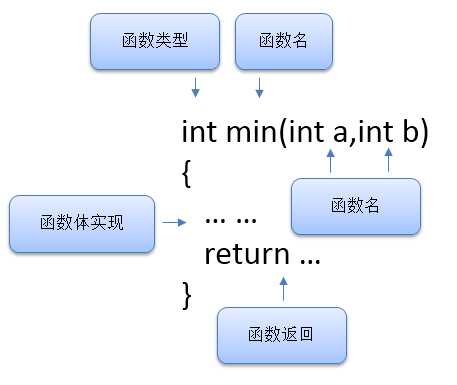标签:
学习总结
1、函数有利于我们可以省去重复的代码,函数可以使程序更加模块化,从而有利于程序的阅读、修改和完善。我们在系统设计或架构设计的时候,往往追求的是模块化、组件化、松耦合,而函数就是其代码的表现。许多程序员喜欢把函数看作“黑盒子”,即对应一定的输入产生特定的结果或返回某个数值,而黑盒子的内部行为并不需要考虑,然而有助于把精力投入到程序整体设计而不是其实现细节。按照C设计原则,我们不应为每个任务编写一个单独的函数,而应该尽量把函数的功能进行抽象设计到达通用目的。
2、函数的组成部分有函数类型、函数名、函数参数(形参)、函数体实现、函数返回(视函数类型而定)。如下图所示:

3、在ANSI C规范之前的传统的函数声明形式是不够准确的,因为它只声明了函数的返回值类型,而没有声明其参数。如int min();这个是ANSI C之前形式的声明通知编译器min()返回一个int类型的数值。然而,该语句并没有说明min()的参数个数和类型。因此,如果在函数min()中使用错误的参数类型和参数个数不对,编译器就不能发现这种错误。
4、一个函数调用其本身的过程被称为递归。递归可以代替循环,反之亦然。递归其优点在于为某些编程问题提供了最简单的解决方法,而缺点是一些递归算法会很快耗尽计算机的内存资源。同时,使用递归的程序难于阅读和维护。
5、与指针相关的运算符:&、*,这两个都是一元运算符。运算符后面跟随一个变量,如&变量为给出该变量的地址,而这个指针地址在大多数系统内部,它是由一个无符号整数表示,但并非可以把指针看作是整数类型,一些处理整数的方法不能用来处理指针。*运算符是用来获取存储在被指向地址中的数值。*指针变量就是获取该存放在该指针变量中的值。
6、指针也是有类型的,什么样的数据类型就需要什么样的类型指针,如整数类型指针定义:
int *pi;
这里的星号(*)表示该变量为一指针。Pi是一个指针,而*pi是一个int类型的指针。
7、函数往往可以通过指针参数来改变外部的变量,如:
1 #include <stdio.h> 2 void changeValue(int *a,int *b); 3 int main(){ 4 int a=1,b=2; 5 changeValue(&a,&b); 6 printf("a=%d,b=%d\n",a,b); 7 return 0; 8 } 9 void changeValue(int *a,int *b){ 10 int temp; 11 temp = *a; 12 *a=*b; 13 *b=temp; 14 }
打印结果:
a=2,b=1
8、编程题(题6)
1 #include <stdio.h> 2 3 double power(double n,int p); 4 5 int main(){ 6 double x,xpow; 7 int exp; 8 9 printf("Enter a number and the positive integer power to which\n"); 10 printf("the number will be reduced.Enter q to quit.\n"); 11 12 while(scanf("%lf%d",&x,&exp)==2){ 13 xpow=power(x,exp); 14 printf("%.3g to the power %d is %.5g\n",x,exp,xpow); 15 printf("Enter next pair of numbers or q to quit.\n"); 16 } 17 18 printf("Hope you enjoyed this power trip --byte!\n"); 19 return 0; 20 } 21 22 double power(double n,int p){ 23 double pow=1; 24 int i; 25 if(n==0) 26 return 0; 27 if(n==1) 28 return 1; 29 for(i=1;i<=p;i++){ 30 pow*=n; 31 } 32 return 1/pow; 33 }
运行结果:
Enter a number and the positive integer power to which
the number will be reduced.Enter q to quit.
2
3
2 to the power 3 is 0.125
Enter next pair of numbers or q to quit.
4
5
4 to the power 5 is 0.00097656
Enter next pair of numbers or q to quit.
1
3
1 to the power 3 is 1
Enter next pair of numbers or q to quit.
1
5
1 to the power 5 is 1
Enter next pair of numbers or q to quit.
0
3
0 to the power 3 is 0
Enter next pair of numbers or q to quit.
0
81
0 to the power 81 is 0
Enter next pair of numbers or q to quit.
q
Hope you enjoyed this power trip --byte!
9、编程题(题7)
1 #include <stdio.h> 2 3 double power(double n,int p,double pow); 4 5 int main(){ 6 double x,xpow; 7 int exp; 8 9 printf("Enter a number and the positive integer power to which\n"); 10 printf("the number will be reduced.Enter q to quit.\n"); 11 12 while(scanf("%lf%d",&x,&exp)==2){ 13 xpow=power(x,exp,1); 14 printf("%.3g to the power %d is %.5g\n",x,exp,xpow); 15 printf("Enter next pair of numbers or q to quit.\n"); 16 } 17 18 printf("Hope you enjoyed this power trip --byte!\n"); 19 return 0; 20 } 21 22 23 double power(double n,int p,double pow){ 24 if(n==0) 25 return 0; 26 if(n==1) 27 return 1; 28 if(p==0) 29 return n; 30 if(p==1) 31 return 1/(n*pow); 32 return power(n,--p,pow*n); 33 }
标签:
原文地址:http://www.cnblogs.com/wcd144140/p/4584076.html